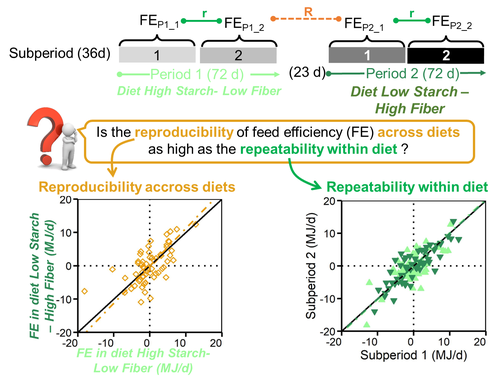
SCHWARM Angela
- Schwarm Lab, Norwegian University of Life Sciences (NMBU), Aas, Norway
- Agricultural sustainability, Animal health, Emissions , Gut function, Microbial fermentation, Ruminant nutrition
- recommender
Recommendations: 0
Review: 1
Review: 1

Feed efficiency of lactating Holstein cows was not as repeatable across diets as within diet over subsequent lactation stages
A focus on feed efficiency reproducibility and repeatability of dairy cows fed different diets over the lactation stage.
Recommended by Alberto Atzori based on reviews by Ioannis Kaimakamis, Angela Schwarm and 2 anonymous reviewersThe topic of feed efficiency is under discussion in the scientific community and several studies pointed out that lactation stage has to be accounted for when estimates of feed efficiency are carried out, especially for genetic ranking of animals and their performances, as highlighted by Li et al. (2017). Other researchers applied a latin square design to test dietary effects across lactation (Ipharraguerre et al. 2002) but this approach cannot be followed out of experimental conditions and particularly does not allow, nowadays, to valorize precision livestock farm data to get phenotypic information from individual animals at farm level.
The current manuscript by Fischer, et al. (2022a) describes an experimental trial in which cows were first fed a high starch diet-low fibre then switched over to a low starch diet-high fibre and individually monitored over time. Data were analyzed with the objective to investigate effects within diets and across diets. Since all cows went through the same sequence at the same time it was not possible to completely separate the confounding effect of lactation stage and diet as stated by the authors. However, this manuscript adds methodological discussions and opens research questions especially to the matter of repeatability and reproducibility of feed efficiency of individual animals over the lactation stage. These variables are fundamental to evaluate nutritional traits and phenotypic performances of dairy cows at farm level, as highlighted by a paper of the same first author (Fischer, et al. 2022b) dealing to reproducibility and repeatability with a similar approach. My opinion is that this manuscript gives the opportunity to enlarge the scientific discussions on the calculation of repeatability and reproducibility of feed efficiency of individual animals over time. In particular, as in this study, specific mathematical approaches need to be carried out with the final goal to analyze and valorize precision livestock farm data for cow phenotyping and to propose new methods of feed efficiency evaluations. It also needs complete databases carried out under experimental conditions. In fact it has to be considered that this manuscript makes available to the scientific community all the data and the R code developed for data analysis giving the opportunity to replicate the calculations and propose new advancements in the feed efficiency evaluations of dairy cows.
References
Fischer A, Gasnier P, Faverdin P (2022a) Feed efficiency of lactating Holstein cows was not as repeatable across diets as within diet over subsequent lactation stages. bioRxiv, 2021.02.10.430560, ver. 3 peer-reviewed and recommended by Peer Community in Animal Science. https://doi.org/10.1101/2021.02.10.430560
Fischer A, Dai X, Kalscheur KF (2022b) Feed efficiency of lactating Holstein cows is repeatable within diet but less reproducible when changing dietary starch and forage concentrations. animal, 16, 100599. https://doi.org/10.1016/J.ANIMAL.2022.100599
Ipharraguerre IR, Ipharraguerre RR, Clark JH (2002) Performance of Lactating Dairy Cows Fed Varying Amounts of Soyhulls as a Replacement for Corn Grain. Journal of Dairy Science, 85, 2905–2912. https://doi.org/10.3168/JDS.S0022-0302(02)74378-6
Li B, Berglund B, Fikse WF, Lassen J, Lidauer MH, Mäntysaari P, Løvendahl P (2017) Neglect of lactation stage leads to naive assessment of residual feed intake in dairy cattle. Journal of Dairy Science, 100, 9076–9084. https://doi.org/10.3168/JDS.2017-12775